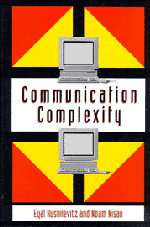Book contents
- Frontmatter
- Contents
- Preface
- I Two-Party Communication Complexity
- II Other Models of Communication
- III Applications
- 8 Networks, Communication, and VLSI
- 9 Decision Trees and Data Structures
- 10 Boolean Circuit Depth
- 11 More Boolean Circuit Lower Bounds
- 12 Time and Space
- 13 Randomness
- 14 Further Topics
- Index of Notation
- A Mathematical Background
- Answers to Selected Problems
- Bibliography
- Index
8 - Networks, Communication, and VLSI
Published online by Cambridge University Press: 05 November 2009
- Frontmatter
- Contents
- Preface
- I Two-Party Communication Complexity
- II Other Models of Communication
- III Applications
- 8 Networks, Communication, and VLSI
- 9 Decision Trees and Data Structures
- 10 Boolean Circuit Depth
- 11 More Boolean Circuit Lower Bounds
- 12 Time and Space
- 13 Randomness
- 14 Further Topics
- Index of Notation
- A Mathematical Background
- Answers to Selected Problems
- Bibliography
- Index
Summary
Results about communication complexity have all kinds of applications. The most obvious ones are applications to communication problems. For example, for the management of a distributed system it is often required to check whether two copies of a file that reside in two different sites are the same. Clearly, this is just solving the “equality” problem EQ, whose communication complexity was extensively studied in the first part of this book. It is also very useful to compare a whole directory. Namely, to get for each file in the directory a bit indicating whether the copies of this particular file are the same or not. This is the same as solving the direct-sum version of EQ (see Section 4.1).
Most of the results in Part III of this book are devoted to applications inwhich communication does not appear explicitly in the statement of the problem. These applications show that in fact communication is an essential part of more problems than it may seem at first glance. We start (in Sections 8.1 and 8.2) with several applications in which the relation to communication complexity is obvious. Then, we show (in Section 8.3) how to apply communication complexity results to the study of VLSI chips.
Bisection Width of Networks
A network of k processors can be viewed as a graph G, where nodes correspond to the processors in the network and edges represent the connection of two processors by a communication channel. We will be proving lower bounds and we will do so regardless of the implementation of “processors” and “channels”. We will only rely on the assumption that in each time step a single bit can be sent on each of the channels.
Information
- Type
- Chapter
- Information
- Communication Complexity , pp. 107 - 113Publisher: Cambridge University PressPrint publication year: 1996
